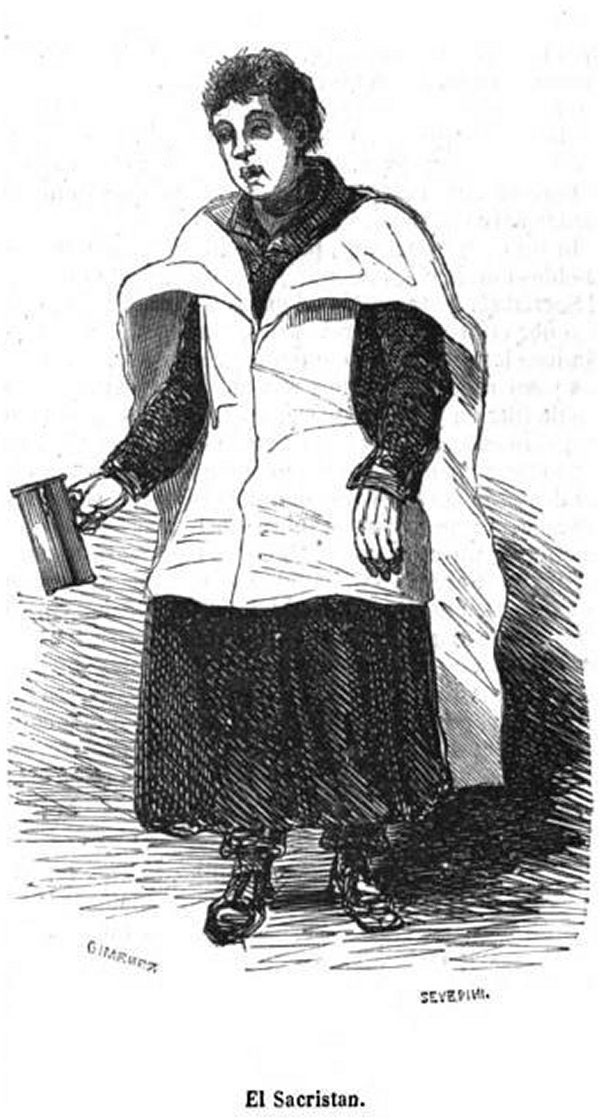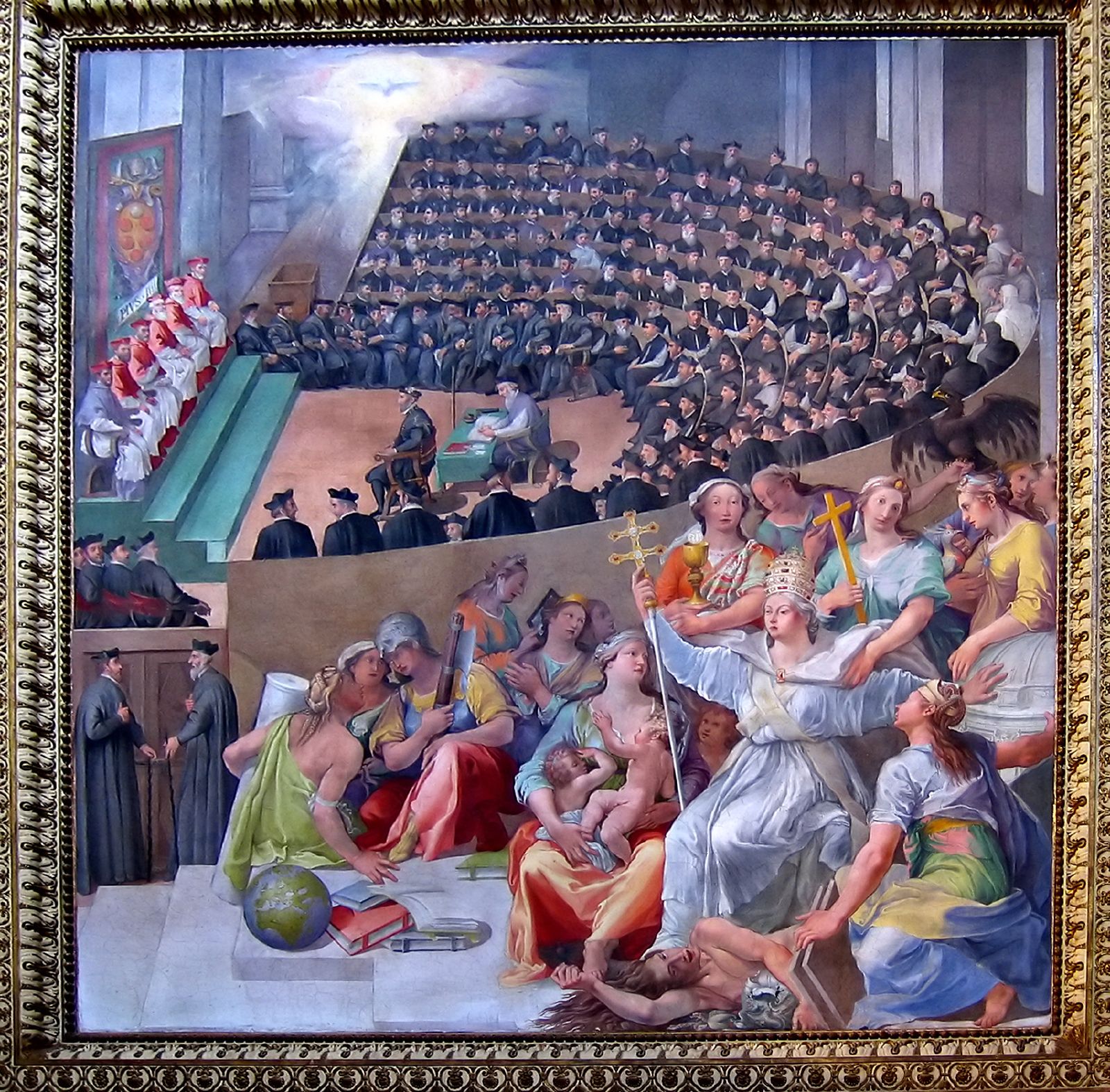|
Sacristan
A sacristan is an officer charged with care of the sacristy, the church, and their contents. In ancient times, many duties of the sacrist were performed by the doorkeepers ( ostiarii), and later by the treasurers and mansionarii. The Decretals of Gregory IX speak of the sacristan as if he had an honourable office attached to a certain benefice, and say that his duty was to care for the sacred vessels, vestments, lights, etc. Nowadays the sacristan is elected or appointed. The '' Cæremoniale Episcoporum'' prescribed that in cathedral and collegiate churches the sacristan should be a priest, and describes his duties in regard to the sacristy, the Blessed Eucharist, the baptismal font, the holy oils, the sacred relics, the decoration of the church for the different seasons and feasts, the preparation of what is necessary for the various ceremonies, the pregustation in pontifical Mass, the ringing of the church bells, the preservation of order in the church, and the distribut ... [...More Info...] [...Related Items...] OR: [Wikipedia] [Google] [Baidu] |
Sexton (office)
A sexton is an officer of a church, congregation, or synagogue charged with the maintenance of its buildings and/or an associated graveyard. In smaller places of worship, this office is often combined with that of verger. Larger establishments, such as cathedrals, may employ a team of sextons. Historically in North America and the United Kingdom the "sexton" was sometimes a minor municipal official responsible for overseeing the town graveyard. In the United Kingdom the position still exists today, related to management of the community's graveyard, with such sextons usually employed by the town/parish or community council. Origin of the name The words "sexton" and " sacristan" both derive from the Medieval Latin word ''sacristanus'' meaning "custodian of sacred objects". "Sexton" represents the popular development of the word via the Old French "Segrestein". Duties Among the traditional duties of the sexton in small parishes was the digging of graves—the The Graved ... [...More Info...] [...Related Items...] OR: [Wikipedia] [Google] [Baidu] |
Sacristy
A sacristy, also known as a vestry or preparation room, is a room in Christianity, Christian churches for the keeping of vestments (such as the alb and chasuble) and other church furnishings, sacred vessels, and parish records. The sacristy is usually located inside the Church (building), church, but in some cases it is an annex or separate building (as in some monastery, monasteries). In most older churches, a sacristy is near a side altar, or more usually behind or on a side of the high altar, main altar. In newer churches the sacristy is often in another location, such as near the entrances to the church. Some churches have more than one sacristy, each of which will have a specific function. Often additional sacristies are used for maintaining the church and its items, such as candles and other materials. Description The sacristy is also where the priest and attendants vest and prepare before the Church service, service. They will return there at the end of the service to r ... [...More Info...] [...Related Items...] OR: [Wikipedia] [Google] [Baidu] |
Ostiarius
An ostiarius, a Latin word sometimes anglicized as ostiary but often literally translated as porter or doorman, originally was an enslaved person or guard posted at the entrance of a building, similarly to a gatekeeper. In the Roman Catholic Church, this "porter" became the lowest of the four minor orders prescribed by the Council of Trent. This was the first order a seminarian was admitted to after receiving the tonsure. The porter had in ancient times the duty of opening and closing the church-door and of guarding the church, especially to ensure no unbaptised persons would enter during the Eucharist. Later on, the porter would also guard, open and close the doors of the sacristy, baptistry and elsewhere in the church. The porter was not a part of holy orders administering sacraments but simply a preparatory job on the way to the major orders: subdiaconate (until its suppression, after the Second Vatican Council by Pope Paul VI), diaconate and the priesthood. Like the o ... [...More Info...] [...Related Items...] OR: [Wikipedia] [Google] [Baidu] |
Laymen
In religious organizations, the laity () — individually a layperson, layman or laywoman — consists of all members who are not part of the clergy, usually including any non-ordained members of religious orders, e.g. a nun or a lay brother. In secular usage, by extension, a layperson is a person who is not qualified in a given profession or is not an expert in a particular field. The phrase " layman's terms" is used to refer to plain language that is understandable to the everyday person, as opposed to specialised terminology understood only by a professional. Terms such as ''lay priest'', ''lay clergy'' and ''lay nun'' were once used in certain Buddhist cultures, especially Japanese, to indicate ordained persons who continued to live in the wider community instead of retiring to a monastery. Some Christian churches utilise lay preachers, who preach but are not clergy. The Church of Jesus Christ of Latter-day Saints uses the term ''lay priesthood'' to emphasise that its lo ... [...More Info...] [...Related Items...] OR: [Wikipedia] [Google] [Baidu] |
Skeuophylax
''Skeuophylax'' (), feminine form ''skeuophylakissa'' (σκευοφυλάκισσα), meaning "keeper of the vessels", is an ecclesiastical office in the Eastern Orthodox Church. Usually held by a priest, the office of the ''skeuophylax'' is entrusted with looking after the sacred vessels and furnishings of a church or monastery. In Byzantine times, the ''skeuophylax'' played an important role in the liturgy, and, alongside the ''oikonomos'' or steward, administered the property of the respective church or monastery. The ''skeuophylax'' of the Great Church (the Hagia Sophia, the cathedral church of the Patriarchate of Constantinople) was distinguished by the epithet ''megas'' ("great"), and was appointed by the Byzantine emperors until the reign of Isaac I Komnenos (r. 1057–59), when the prerogative passed to the patriarchs. Until the late 11th century, the ''megas skeuophylax'' (μέγας σκευοφύλαξ) ranked second in the administrative hierarchy, after the ''megas o ... [...More Info...] [...Related Items...] OR: [Wikipedia] [Google] [Baidu] |
Monastery
A monastery is a building or complex of buildings comprising the domestic quarters and workplaces of Monasticism, monastics, monks or nuns, whether living in Cenobitic monasticism, communities or alone (hermits). A monastery generally includes a place reserved for prayer which may be a chapel, Church (building), church, or temple, and may also serve as an Oratory (worship), oratory, or in the case of Cenobium, communities anything from a single building housing only one senior and two or three junior monks or nuns, to vast complexes and estates housing tens or hundreds. A monastery complex typically comprises a number of buildings which include a church, dormitory, cloister, refectory, library, Wiktionary:balneary, balneary and Hospital, infirmary and outlying Monastic grange, granges. Depending on the location, the monastic order and the occupation of its inhabitants, the complex may also include a wide range of buildings that facilitate self-sufficiency and service to the commun ... [...More Info...] [...Related Items...] OR: [Wikipedia] [Google] [Baidu] |
Eastern Christianity
Eastern Christianity comprises Christianity, Christian traditions and Christian denomination, church families that originally developed during Classical antiquity, classical and late antiquity in the Eastern Mediterranean region or locations further east, south or north. The term does not describe a single Communion (Christian), communion or religious denomination. Eastern Christianity is a category distinguished from Western Christianity, which is composed of those Christian traditions and churches that originally developed further west. Major Eastern Christian bodies include the Eastern Orthodox Church and the Oriental Orthodox Churches, along with those groups descended from the historic Church of the East (also called the Assyrian Church (other), Assyrian Church), as well as the Eastern Catholic Churches (which are in communion with Holy See, Rome while maintaining Eastern Catholic liturgy, Eastern liturgies), and the Eastern Protestant Christianity, Eastern Protest ... [...More Info...] [...Related Items...] OR: [Wikipedia] [Google] [Baidu] |
Clerics
Clergy are formal leaders within established religions. Their roles and functions vary in different religious traditions, but usually involve presiding over specific rituals and teaching their religion's doctrines and practices. Some of the terms used for individual clergy are clergyman, clergywoman, clergyperson, churchman, cleric, ecclesiastic, and vicegerent while clerk in holy orders has a long history but is rarely used. In Christianity, the specific names and roles of the clergy vary by denomination and there is a wide range of formal and informal clergy positions, including deacons, elders, priests, bishops, cardinals, preachers, pastors, presbyters, ministers, and the pope. In Islam, a religious leader is often known formally or informally as an imam, caliph, qadi, mufti, sheikh, mullah, muezzin, and ulema. In the Jewish tradition, a religious leader is often a rabbi (teacher) or hazzan (cantor). Etymology The word ''cleric'' comes from the ecclesia ... [...More Info...] [...Related Items...] OR: [Wikipedia] [Google] [Baidu] |
Council Of Trent
The Council of Trent (), held between 1545 and 1563 in Trent (or Trento), now in northern Italy, was the 19th ecumenical council of the Catholic Church. Prompted by the Protestant Reformation at the time, it has been described as the "most impressive embodiment of the ideals of the Counter-Reformation.""Trent, Council of" in Cross, F. L. (ed.) ''The Oxford Dictionary of the Christian Church'', Oxford University Press, 2005 (). It was the last time an ecumenical council was organized outside the city of Rome. The Council issued key statements and clarifications of the Church's doctrine and teachings, including scripture, the biblical canon, sacred tradition, original sin, justification, salvation, the sacraments, the Mass, and the veneration of saintsWetterau, Bruce. ''World History''. New York: Henry Holt and Company, 1994. and also issued condemnations of what it defined to be heresies committed by proponents of Protestantism. The consequences of the council were als ... [...More Info...] [...Related Items...] OR: [Wikipedia] [Google] [Baidu] |
Archdeacon
An archdeacon is a senior clergy position in the Church of the East, Chaldean Catholic Church, Syriac Orthodox Church, Anglican Communion, St Thomas Christians, Eastern Orthodox Church, Eastern Orthodox churches and some other Christian denominations, above that of most clergy and below a bishop. In the High Middle Ages it was the most senior diocesan position below a bishop in the Catholic Church. An archdeacon is often responsible for administration within an archdeaconry, which is the principal subdivision of the diocese. The ''Oxford Dictionary of the Christian Church'' has defined an archdeacon as "A cleric having a defined administrative authority delegated to him by the bishop in the whole or part of the diocese.". The office has often been described metaphorically as ''oculus episcopi'', the "bishop's eye". Catholic Church In the Latin Catholic Church, the post of archdeacon, originally an ordained deacon (rather than a priest), was once one of great importance as a sen ... [...More Info...] [...Related Items...] OR: [Wikipedia] [Google] [Baidu] |
083 Jules Breton Le Bedeau De Kerlaz
83 may refer to: * 83 (number) * one of the years 83 BC, AD 83, 1983, 2083 * 83 (film), ''83'' (film), a 2021 Indian Hindi film. * "83", a song by John Mayer on his 2001 album ''Room for Squares'' * ''83'', a combined-arms tactical first-person shooter game, Rising Storm 2: Vietnam#Successor, successor to ''Rising Storm 2: Vietnam'' * 83 Beatrix, a main-belt asteroid See also * * List of highways numbered {{Numberdis ... [...More Info...] [...Related Items...] OR: [Wikipedia] [Google] [Baidu] |







